Discrete Voltage Controlled Oscillator block
Figure 1: Output waveform of a Voltage Controlled Oscillator
This block would like to realize a time domain waveform of a Voltage Controlled Oscillator described by this expression:
where phi(t) is the state variable of the oscillator (instaneous phase) computed with the formula:
where :
- kv is a linear sensitivity of the oscillator,
- F() a nonlinear tunning characteristic,
- n(t) a White Gaussian Noise,
- and u3(t) the input control voltage (the first regular input port).
This block is a Discrete Basic Block(DBB) and the integration of the instaneous phase is computed by a trapezoidal rule.
The period of event input port that must be informed by the 'Step' dialog parameter, is the discrete integration time step.
Figure 2: Discrete time output waveform of a Voltage Controlled Oscillator
This block includes two discrete frequency dividers, with one dynamically computed.
The event output port(s) is(are) the zero crossing date of the output waveform produced by the frequency dividers.
Full possibilities of this block are described in the following 'Super Block equivalent Model' section.
(cf "Dialog Box" and "See Also" sections for further details)
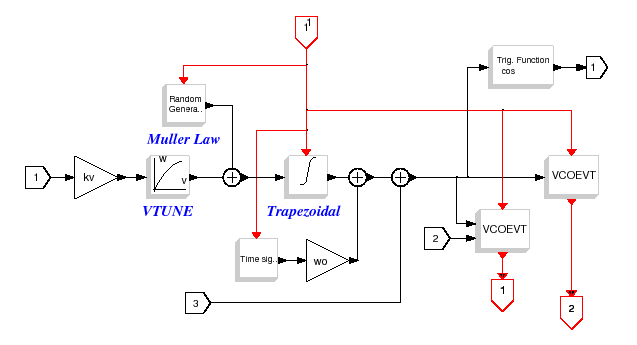
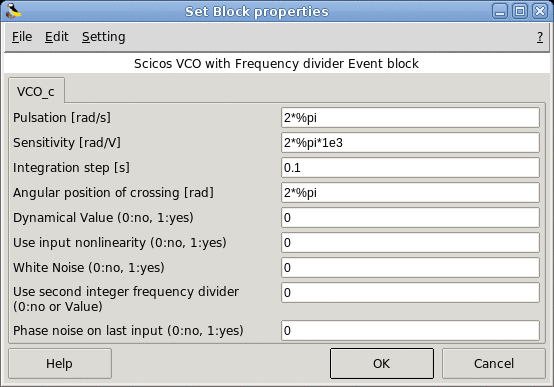
- Pulsation [rad/s]
The free running pulsation.
Properties : Type 'vec' of size -1.
- Sensitivity [rad/V]
The linear sensitivity (if any).
Properties : Type 'vec' of size -1.
- Integration step [s]
The time step integration.
Properties : Type 'vec' of size 1.
- Angular position of crossing [rad]
The angular position to detect for event generation of the first frequency divider.
Properties : Type 'vec' of size 1.
- Dynamical Value (0:no, 1:yes)
Draw another regular input port that gives the dynamical factor value of the first frequency divider.
The angular position to detect will be multiplied with the value provided
by this other regular input port.
Properties : Type 'vec' of size 1.
- Use input nonlinearity (0:no, 1:yes)
Enable a static nonlinear frequency/voltage characteristic
for the input voltage defined by :
Properties : Type 'vec' of size 1.
If set 1
- Gain
Gain ( ) of nonlinear function.
) of nonlinear function.
Properties : Type vec of size 1.
- Coefficient
Coefficient ( ) of nonlinear function.
) of nonlinear function.
Properties : Type vec of size 1.
- Plot nonlinearity (0:no, or winid)
Plot nonlinear function in a scilab window.
Properties : Type vec of size 1.
- White Noise (0:no, 1:yes)
Add a white gaussian noise source on the input voltage.
Properties : Type 'vec' of size 1.
If set 1
- Mean [rad/v]
Mean of white noise source.
Properties : Type vec of size 1.
- Variance [rad/v]
Variance of white noise source.
Properties : Type vec of size 1.
- Use second integer frequency divider (0:no or value)
Draw a second output event port which computes a second static frequency divider.
The angular position to detect is set with the value given by this dialog
parameter if different of zero.
Properties : Type 'vec' of size 1.
- Phase noise on last input (0:no, 1:yes)
This enables another regular input port to enter additive time domain phase
noise in the oscillator.
Under this condition, the output of the oscillator will be described by :
with
 noisy samples added by the last regular
input port.
noisy samples added by the last regular
input port.
Properties : Type 'vec' of size 1.
- always active: no
- direct-feedthrough: no
- zero-crossing: no
- mode: no
- regular inputs:
- port 1 : size [1,1] / type 1
- regular outputs:
- port 1 : size [1,1] / type 1
- number/sizes of activation inputs: 1
- number/sizes of activation outputs: 1
- continuous-time state: no
- discrete-time state: yes
- object discrete-time state: no
- name of computational function: vcoblk
- MODNUMCOS/macros/scicos_blocks/Pll/VCO_c.sci [view code]
A. Layec
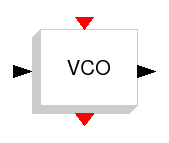

![]()
![]()


![]()
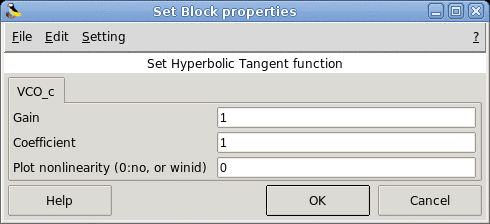
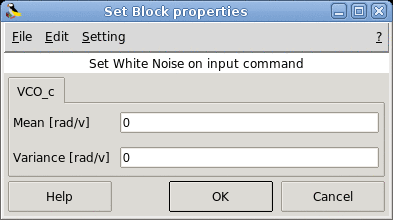
![]()